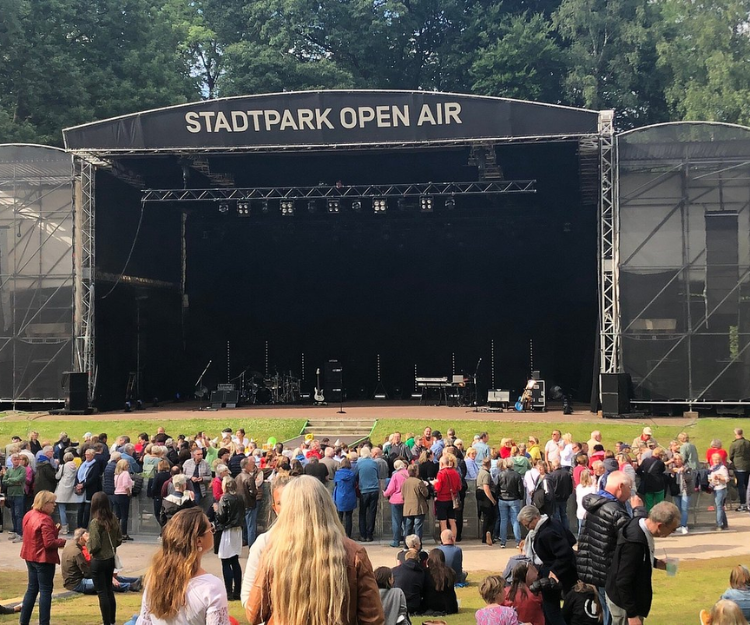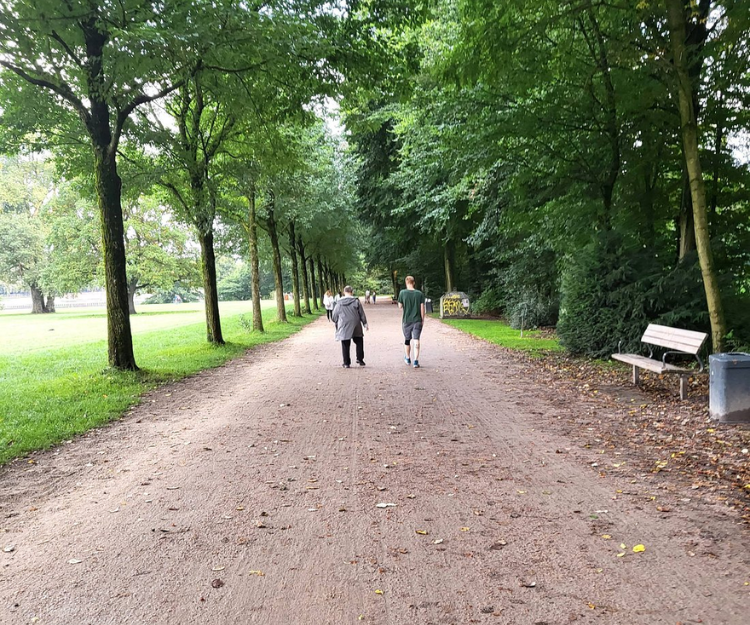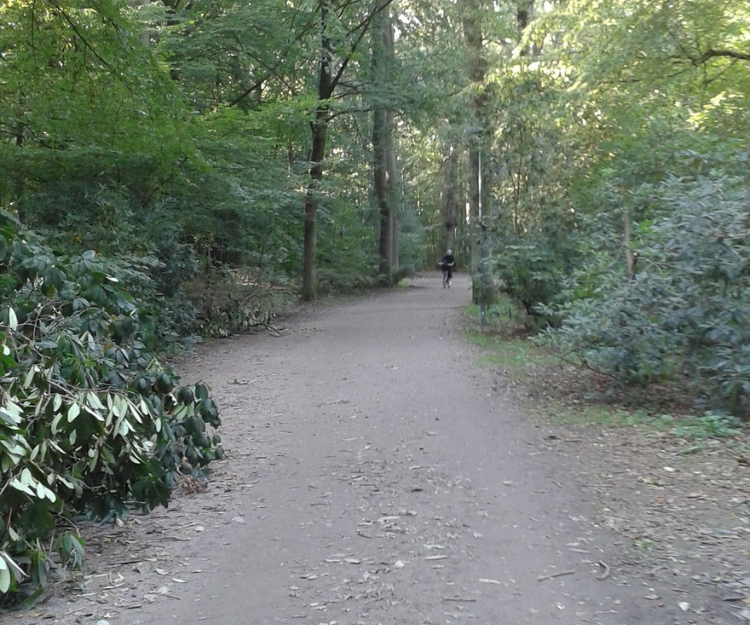
Stadtpark, also known as Hamburg City Park, is situated in the Winterhude district of Hamburg, Germany. This expansive urban park covers approximately 148 hectares (about 365 acres) and is one of the largest parks in the city. Here are some specific details about its location and features:
1. **Geographical Boundaries**:
- **North**: Bounded by the streets Hindenburgstra├če and Alte W├Âhr.
- **East**: Bordered by Saarlandstra├če.
- **South**: Lined by the S├╝dring road.
- **West**: Defined by the street called Linnering.
2. **Access Points**:
- The main entrance is near the Hamburg Planetarium, which is one of the parkÔÇÖs key landmarks.
- Other notable entrances include those near Borgweg, City Nord, and Goldbekkanal.
3. **Landmarks and Facilities**:
- **Hamburg Planetarium**: Located within the park, itÔÇÖs one of the world's oldest and most renowned planetariums.
- **Large Meadow (Gro├če Festwiese)**: A large open space often used for festivals, concerts, and recreational activities.
- **Boating Lake (Stadtparksee)**: Offers boat rentals and is a popular spot for relaxing by the water.
- **Open-Air Theatre (Freilichtb├╝hne)**: Hosts various cultural events and performances during the summer months.
- **Rose Garden (Rosengarten)**: A beautifully maintained garden featuring a wide variety of roses.
- **Sports Facilities**: Includes tennis courts, a swimming pool, and numerous paths for running, walking, and cycling.
- **Playgrounds and Picnic Areas**: Designed for families and visitors to enjoy outdoor activities.
4. **Transportation**:
- **Public Transport**: Easily accessible via HamburgÔÇÖs public transport system, with nearby U-Bahn (subway) stations such as Borgweg (U3 line) and Saarlandstra├če (U3 line).
- **Cycling and Walking**: The park is well-connected by bike paths and pedestrian walkways, making it a convenient destination for locals and tourists alike.
Stadtpark is a central recreational hub for HamburgÔÇÖs residents and visitors, offering a blend of natural beauty, cultural landmarks, and recreational facilities.

Stadtpark in Hamburg officially opened to the public in 1914. The park was designed by Fritz Schumacher and Friedrich Sperber, and it was developed as part of a larger urban planning initiative to provide green spaces and recreational areas for the city's residents. Over the years, Stadtpark has evolved and expanded, becoming one of Hamburg's most cherished public parks.
Stadtpark in Hamburg undergone several developments since its opening in 1914:
1. **Design and Creation**: The park was designed by city planner Fritz Schumacher and landscape architect Friedrich Sperber. It was part of Hamburg's progressive urban planning efforts in the early 20th century to provide green spaces for recreation and relaxation amid the city's industrialization.
2. **Expansion and Features**: Over the decades, Stadtpark has expanded and added various features to enhance its appeal to visitors. These include the Hamburg Planetarium, which opened in 1930 and is one of the park's most iconic landmarks.
3. **Cultural and Recreational Hub**: Stadtpark has become a cultural hub hosting concerts, festivals, and other events. The Open-Air Theatre (Freilichtb├╝hne), built in the 1930s, is a venue for performances during the summer months. The park's large meadow (Gro├če Festwiese) is also used for major events and gatherings.
4. **Natural and Architectural Highlights**: Apart from its recreational facilities, Stadtpark boasts several natural and architectural highlights. These include the Stadtparksee (boating lake), the Rose Garden (Rosengarten), various sculptures and monuments, and extensive walking and cycling paths.
5. **Community Use and Accessibility**: Stadtpark is widely used by Hamburg residents for leisure activities such as jogging, picnicking, and boating. It is easily accessible via public transportation, making it a popular destination year-round.

Stadtpark in Hamburg was designed and created by two key figures: Fritz Schumacher and Friedrich Sperber.
1. **Fritz Schumacher**: He was a prominent architect and urban planner who served as the Chief Building Director of Hamburg from 1909 to 1933. Schumacher played a pivotal role in shaping the city's architecture and urban development during the early 20th century. His vision for Stadtpark integrated the principles of urban planning with the need for green spaces to enhance the quality of life for Hamburg's residents.
2. **Friedrich Sperber**: He was a landscape architect who collaborated with Fritz Schumacher on several projects, including the design and development of Stadtpark. Sperber's expertise in landscape architecture contributed to creating a harmonious balance between natural elements and structured amenities within the park.
Together, Fritz Schumacher and Friedrich Sperber are credited with inventing the concept and layout of Stadtpark, which has since become a beloved landmark and recreational oasis in Hamburg, Germany.

The name "Stadtpark" translates from German as "City Park." It is called Stadtpark because it serves as a centrally located urban park within the city of Hamburg, Germany. The park was designed and created to provide a large green space for the city's residents, offering recreational activities, cultural events, and natural surroundings amidst the urban environment.
The designation "Stadtpark" emphasizes its role as a public park within the city limits, distinguishing it from smaller neighborhood parks or rural parks located outside urban areas. It signifies its importance as a communal area where residents can enjoy nature, participate in leisure activities, and engage in cultural events, all within the confines of Hamburg's urban landscape.




Stadtpark in Hamburg, while primarily known as an urban park with various recreational facilities, may not traditionally be considered a destination for hiking enthusiasts seeking rugged terrain or extensive trails. However, it does offer several features that can appeal to hiking lovers in a different context:
1. **Walking Paths and Trails**: Stadtpark has numerous well-maintained paths and trails that wind through its expansive grounds. These paths provide opportunities for leisurely walks and shorter hikes amidst greenery and natural landscapes.
2. **Varied Terrain and Scenery**: Despite being within an urban area, Stadtpark offers diverse terrain and scenic views, including wooded areas, open meadows, and the picturesque Stadtparksee (boating lake). This variety can make for enjoyable walks and hikes, especially for those looking to explore natural settings within a city environment.
3. **Accessibility and Amenities**: The park is easily accessible via public transportation, making it convenient for hikers to reach. It also features amenities such as benches, picnic areas, and refreshment stands, which can enhance the hiking experience by providing places to rest and rejuvenate.
4. **Cultural and Natural Highlights**: Hiking in Stadtpark allows visitors to discover cultural landmarks such as the Hamburg Planetarium and the Open-Air Theatre (Freilichtb├╝hne), which often hosts performances during the summer months. The park's Rose Garden (Rosengarten) and various sculptures add to its charm and provide points of interest along hiking routes.
5. **Integration with City Life**: Stadtpark's location within Hamburg means that hikers can easily combine their outdoor activities with exploring nearby attractions, restaurants, and shops, thereby enjoying a balanced experience of nature and urban life.
While Stadtpark may not offer the extensive wilderness trails found in more rural or mountainous regions, its blend of natural beauty, cultural amenities, and accessible pathways can certainly appeal to hiking lovers looking to enjoy a peaceful and scenic outdoor experience within a city setting.






Stadtpark in Hamburg can indeed be enjoyed for hiking throughout the year, with each season offering its own unique experiences and attractions:
1. **Spring**: As the weather warms up, Stadtpark bursts into life with blooming flowers in the Rose Garden and throughout the park. The fresh greenery and mild temperatures make it an ideal time for leisurely walks and hikes.
2. **Summer**: Summer brings long daylight hours, making it perfect for early morning or evening hikes when the park is quieter. The Open-Air Theatre often hosts concerts and performances, adding to the cultural ambiance of the park.
3. **Autumn**: The changing colors of the leaves create a picturesque backdrop for hiking in Stadtpark. The crisp air and cooler temperatures make for comfortable walking conditions, and the park's foliage takes on vibrant hues.
4. **Winter**: Even in winter, Stadtpark can be a serene destination for hiking. The park's pathways are usually well-maintained, and a dusting of snow can create a peaceful atmosphere. The Hamburg Planetarium and other indoor attractions provide options for warming up after a hike.
Throughout the year, Stadtpark's network of trails and paths offer opportunities for hikers to explore its varied landscapes, from wooded areas to open meadows and the shores of the Stadtparksee. Whether you're looking for a brisk walk, a leisurely stroll, or a chance to connect with nature amidst an urban environment, Stadtpark provides a versatile and enjoyable hiking experience in every season.